The following interview was conducted at the Kadena NCO Club located at Kadena Air Base, Okinawa. Present were Soken Hohan and one of his senior student, Kise Fusei. Soken is a Shihan 10-Dan in Shorinryu Matsumura Seito Karate-do. His honbu dojo is located at 104 Gaja, Nishihara City, Okinawa Prefecture, Japan.
The date of the interview was September 10, 1978. The interview was conducted in Spanish to the great annoyance of Kise. Soken spoke excellent Spanish due to the fact that he had lived in Argentina for over twenty-five years. I should also make mentioned that I was a Spanish language translator for the Pentagon for two plus years and worked in Washington, D.C., hence, I am familiar with the language.
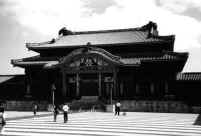
Shuri castle
Interviewer: Sensei, can you please identify yourself.
Soken-sensei: My name is Soken Hohan and I was born on May 25, 1889. I come from (I live in) Gaja Village, Nishihara City, Okinawa Prefecture. I am a native Okinawan. My style is officially called the Matsumura Orthodox Shorin-ryu Karate-do and I am a Shihan 10-Dan. My honbu dojo is presently located at Gaja Village, Nishihara City.
My style comes from Kayo Soken. To mark the occasion when Kayo was appointed the chief body-guard to King Sho Ko (and later to Sho Iku and then Sho Tai), he was allowed to change his name. This was a custom back then, especially if something important or notable happened to you; he changed his name to Matsumura, — Matsumura Soken.
It was later that King Sho Tai officially gave Matsumura the title of “Bushi” { The term “bushi” is different from the Japanese meaning. In Japan a “bushi,” in simplistic terms, is a warrior. In Okinawa, the term “bushi” also refers to the individual being a martial-man/warrior but with a strong slant to also being a true gentleman — hence, the meaning, “a gentleman warrior.” – ed} and to this day he is, with affection, referred to as Bushi Matsumura.
When Bushi Matsumura died he left the “hands” of his teachings to my uncle, who was his grandson, Matsumura Nabe. My mother
was Nabe-tanmei’s sister. Tanmei means “respected senior or
respected old man,” this was and still is a title of much respect
in Okinawa. I became a student of my uncle around 1902 or 1903 and learned the original methods of Uchinan Sui-di, as it was then called.
Back then, there weren’t large followings of students for a master of the warrior arts. Itosu Ankoh had less than a dozen students and he was one of the greatest of teachers at the time. My uncle had only one student, and that was me. He was still a practitioner with an “old mind” and would only teach or demonstrate for family members. Since I was the most interested, he allowed me to become his student.
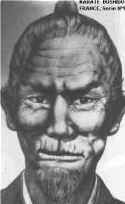
Bushi Mutsumura
I should also state that Matsumura Orthodox is not the only authentic shorin-ryu style. This style, my style, was passed on from Matsumura Sokon to my uncle, Nabe-tanmei but Nabe-tanmei was not Bushi Matsumura’s only student. Matsumura had a good dozen or so dedicated students. Each
one learned his methods and then expanded on them.
My uncle only learned from Bushi Matsumura and only taught me what he had learned. So, it can be said that it is an “old version”
with no updates. By studying my Matsumura Orthodox you walk back into ancient times when karate was more forceful and challenging.
Interviewer: Sensei, can you tell me something about your training methods?
Sensei: Old training was always done in secret so that others would not steal your techniques. Nabe initially taught me stepping before anything. He would cut the leaves off the banana tree and place them on the ground. He would then have me do exercises to develop balance. If the balance was not good you would fall and since the exercises were always vigorous, a fall could seriously hurt you.
We would also use the pine trees that were found throughout Okinawa. We would slap or kick the trees and develop our gripping methods for close in fighting. This kind of training was very hard and severe on a person who had to work hard all day and then train hard at night. Life was very hard back then.
We would train twice a day. Early in the morning we would train on
striking objects and conditioning to prepare one for the day. After
working hard in the fields, we would have nightly training in two person techniques and conditioning like present-day kotekitai. We had to toughen our legs and hands – like iron, then they became true weapons. During the late hours we would practice the kata of Matsumura.
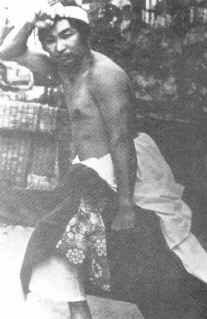
Photo of Mutsumura?
Interviewer: Can you tell me something about the kata you teach.
Sensei: Well, kata, yes, the most important Matsumura Seito kata is the kusanku. Sometmes we would practice the kusanku with kanzashi (hairpins) held in the hands – this was a common method of fighting. The hairpins were symbols of rank and many Okinawans carried them for decoration and also for protection.
Interviewer: I understand that you teach a white crane form. Is this the hakucho kata?
Sensei: No, hakucho, is another kata that, I believe, came from the Chinese tea seller, Go Kenki. He moved to Japan but my kata is much different. I call it hakutsuru. It was about… no, it was after ten years of training my uncle taught me the most secret kata of Matsumura Seito shorin-ryu, the hakutsuru (white crane) kata. This form stressed the balance — all the Matsumura kata stressed balance but this form was the most dangerous in training.
The practice of the hakutsuru form forced me to learn better balance by performing the techniques while balanced on a pine log. Initially I learned the form on the ground and then I had to perform it on a log laying on the ground. For the advanced training the log was put into the river and tied down so as not to float away. I was then instructed to perform the kata while balanced on the log. It was very difficult and I almost drowned several times by falling and bouncing my head off the log.
Interviewer: You are recognized as a leading practitioner of
traditional weaponry. Can you tell something about your weapons
training?
Sensei: I studied traditional weaponry under Komesu Ushi-no-tanmei and later under Tsuken Mantaka. Tsuken is known for the bo form called Tsuken-nu-kun or Tsuken-bo. It is very famous.
Interviewer: Sensei, you speak excellent Spanish. Where did you learn to speak Spanish?
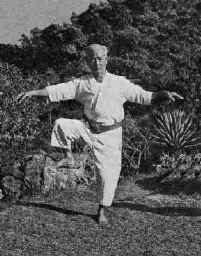
Hohan Soken – Crane stance
Sensei: Yes, Spanish. In 1924 I moved to Buenos Aires, Argentina, to find my fortune. I apprenticed myself as a photographer and later I worked in the clothes cleaning business. I learned Spanish there and I taught karate after they found out who I was. Most of my students in Argentina came from the Okinawan community – some Japanese.
All in all, in Argentina, I only had a small handful of students but
we gave numerous demonstrations throughout the country. There were many, many Okinawans and Japanese living in Argentina. I returned to Okinawa in 1952.
Interviewer: What happened when you returned to Okinawa?
Sensei: I did not teach karate at first. Yes, not to the public but I
began to teach a few family members which then opened up to a small dojo. I initially called it by the “hogen” name Machimura sui-de or in Japanese, Matsumura Shuri-te.
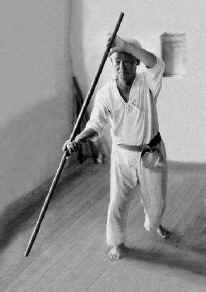
Sensei Soken – Bo jutsu (pictures are taken from SHOKA web site)
Around 1956 I changed the name of my teachings to Matsumura Orthodox Shorin-ryu karate-do. I still trained in the old ways and did not understand the new methods that were being taught. It appeared to be softer and more commercial. Because of this, I did not join the new organizations that were being formed at the time. My old way of karate was not readily accepted by everyone. They thought it too old and too crude — I think it was just too hard or maybe my training methods were too severe. Whatever it was, it was the way I learned and the way I taught. It was later, when the Americans came to learn, that I changed my ways.
I found that there were two kinds of students – one was a dedicated and motivated student who wants to learn the Okinawan martial arts. The other is an individual who only wants to say he is learning karate. There are more of the latter. It is the latter that you see everywhere. They say that they “know” karate or that they “use to” practice karate – these are worthless individuals.
Go to – Interview with Hohan Soken, Mutsumura’s grandson – part II
The following interview with Hohan Soken is made by Ernest Estrada.

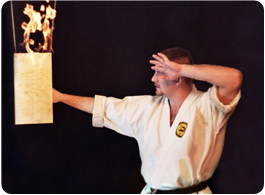

where could i be able to locate a book or biography about hohan soken? please reply, as soon as possible
The photo you have captioned as a possible photo of Matsumura is a picture of an actor who portrayed him in a modern film. I don’t have the reference at hand, but it may have been clarified in one of Nagamine’s books.
Historically, given the usual dates for his birth, Matsumura would have been in his 50’s or 60’s when cameras made their way to Ryukyu, putting the possible date for this picture’s creation in the 1850’s or 60’s. This alone makes it’s authenticity highly unlikely- all of the images that we have of Ryukyu from the 1850’s-60’s are daguerreotypes or lithographs, like the portrait posted above the actor shot. There’s also the fact that there are no known images of anyone practicing karate from that time period, and the Ryukyuans would not have demonstrated a Chinese art in front of visitors (Perry and his crew) who were there to seek an audience with the Japanese. In the one brief reference to a Ryukyuan assuming a fighting posture in front of an American sailor after a misunderstanding, he immediately played it off and nothing further is mentioned in the Perry Expedition journals.
sensei i want to your karate style from lndia
I believe the man in the photo is none other than Shuguro Nakazato, taken a WHILE back, portraying Bushi Matsumura
This is a very interesting interview. Regards from Poland.
His home an dojo a 5
His bo photo is a naginata kata